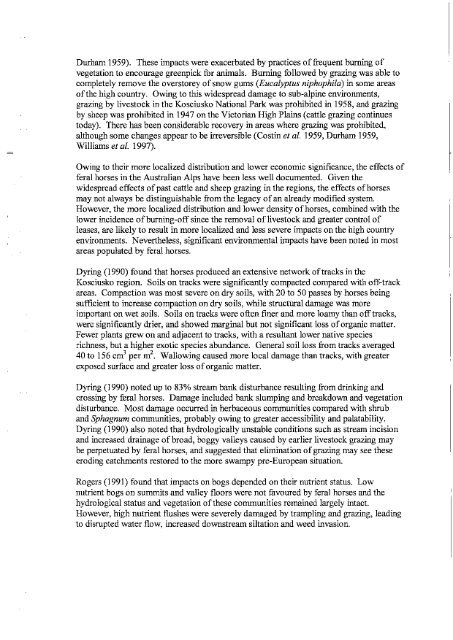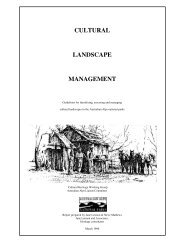Assessment of Impacts of Feral Horses - Australian Alps National ...
Assessment of Impacts of Feral Horses - Australian Alps National ...
Assessment of Impacts of Feral Horses - Australian Alps National ...
Create successful ePaper yourself
Turn your PDF publications into a flip-book with our unique Google optimized e-Paper software.
Durham 1959). These impacts were exacerbated by practices <strong>of</strong> frequent burning <strong>of</strong><br />
vegetation to encourage green pick for animals. Burning followed by grazing was able to<br />
completely remove the overstorey <strong>of</strong> snow gums (Eucalyptus niphophila) in some areas<br />
<strong>of</strong> the high country. Owing to this widespread damage to sub-alpine environments,<br />
grazing by livestock in the Kosciusko <strong>National</strong> Park was prohibited in 1958, and grazing<br />
by sheep was prohibited in 1947 on the Victorian High Plains (cattle grazing continues<br />
today). There has been considerable recovery in areas where grazing was prohibited,<br />
although some changes appear to be irreversible (Costin et al. 1959, Durham 1959,<br />
Williams et al. 1997).<br />
Owing to their more localized distribution and lower economic significance, the effects <strong>of</strong><br />
feral horses in the <strong>Australian</strong> <strong>Alps</strong> have been less well documented. Given the<br />
widespread effects <strong>of</strong> past cattle and sheep grazing in the regions, the effects <strong>of</strong> horses<br />
may not always be distinguishable from the legacy <strong>of</strong> an already modified system.<br />
However, the more localized distribution and lower density <strong>of</strong> horses, combined with the<br />
lower incidence <strong>of</strong> burning-<strong>of</strong>f since the removal <strong>of</strong>livestock and greater control <strong>of</strong><br />
leases, are likely to result in more localized and less severe impacts on the high country<br />
environments. Nevertheless, significant environmental impacts have been noted in most<br />
areas populated by feral horses.<br />
Dyring (1990) found that horses produced an extensive network <strong>of</strong> tracks in the<br />
Kosciusko region. Soils on tracks were significantly compacted compared with <strong>of</strong>f-track<br />
areas. Compaction was most severe on dry soils, with 20 to 50 passes by horses being<br />
sufficient to increase compaction on dry soils, while structural damage was more<br />
important on wet soils. Soils on tracks were <strong>of</strong>ten finer and more loamy than <strong>of</strong>f tracks,<br />
were significantly drier, and showed marginal but not significant loss <strong>of</strong> organic matter.<br />
Fewer plants grew on and adjacent to tracks, with a resultant lower native species<br />
richness, but a higher exotic species abundance. General soil loss from tracks averaged<br />
40 to 156 cm 3 per m 2 • Wallowing caused more local damage than tracks, with greater<br />
exposed surface and greater loss <strong>of</strong> organic matter.<br />
Dyring (1990) noted up to 83% stream bank disturbance resulting from drinking and<br />
crossing by feral horses. Damage included bank slumping and breakdown and vegetation<br />
disturbance. Most damage occurred in herbaceous communities compared with shrub<br />
and Sphagnum communities, probably owing to greater accessibility and palatability.<br />
Dyring (1990) also noted that hydrologically unstable conditions such as stream incision<br />
and increased drainage <strong>of</strong> broad, boggy valleys caused by earlier livestock grazing may<br />
be perpetuated by feral horses, and suggested that elimination <strong>of</strong> grazing may see these<br />
eroding catchments restored to the more swampy pre-European situation.<br />
Rogers (1991) found that impacts on bogs depended on their nutrient status. Low<br />
nutrient bogs on summits and valley floors were not favoured by feral horses and the<br />
hydrological status and vegetation <strong>of</strong> these communities remained largely intact.<br />
However, high nutrient flushes were severely damaged by trampling and grazing, leading<br />
to disrupted water flow, increased downstream siltation and weed invasion.
















